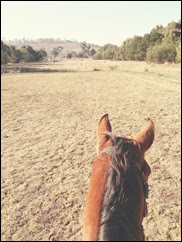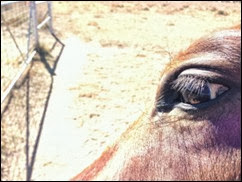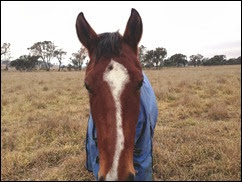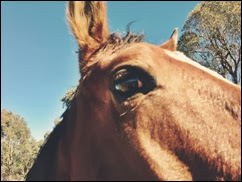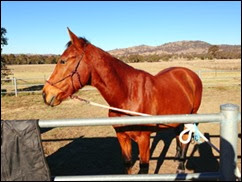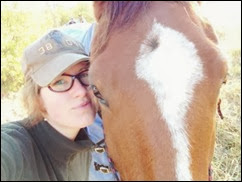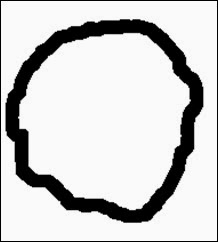Or more accurately, some muddle is happening!
My ride on Copper today was productive, I think… I don’t really know, as I can only go off what I feel, but because I’ve only read about the results I want, and never actually ridden them, how am I supposed to know?
What we worked on:
Warm up - I let him pick the direction, the pace and gait, and only used contact to steer to keep him in the arena as it is not fenced, just denoted by poles on the ground.
Trot – Me; trying to deepen my seat and practice my half-halts. Him; shoulder-ins and leg yields at the trot as well as some figure of eights thrown in for good measure.
Canter – Me; suppleness through my shoulders, arms and wrists; activating my seat at a canter, rather than just sitting and moving with it. Him; balance, rather than racing to maintain the gait.
What it felt like:
Warm up – Copper loved this bit, what horse wouldn’t? (Well – not quite, Joey would just mooch) He chose the right rein and powered around in an explosive, fast trot. He would slow down for the corners, but yeesh. It was messy. I just focused on keeping up with him and staying balanced. The reason I decided to do this is because a trainer that I greatly admire, Mugwump, is great believer in getting off a horse’s face and letting them figure it out. By all means, steer with the reins, do your figures, but keep out of their face. The more you can do that, the less charge-y and pull-y they will be.
I think I might need to try this a few more times before Copper gets the hang of it, his first and only thought was “Yay! Running!” After a while he seemed to calm down a wee bit, and I do mean wee, so I thought it was time to pick up contact again, and do some ‘proper’ work.
Trot – Me; I was trying to deepen my seat, but avoid the pinch-y thigh problems that can occur when you are trying to change your balance or keep up with the horse’s movement. This meant that I would open my hips and thighs, apply a little calf and gentle resistance on the reins to do my half halts.
It felt weird to say the least. I could feel my seat bones drop into the saddle, and that was good, but pulling my thighs open to achieve that felt messy. It could be that I’m not used to the motion yet. I have found that when you start trying new positions in the saddle, or new aids you don’t know, they almost always feel messy at first – even if they are correct. Or, it could be that I don’t need to swing my knees out so much when I am trying to open up my hips. I shall have to experiment.
Copper; still felt excited and charge-y. I wanted his energy to be ‘up’ but I don’t think he has the muscle strength to lift up his neck and head in proportion to his impulsion – so he had to go forwards, or else he would drive himself onto his forehand. (Much like Joey used to do.) I would half-halt and he would respond and drop his croup, but as soon as I released the resistance on the reins with the next stride, he would just explode forwards, because, I am guessing, he was unable to contain his energy.
I would fall behind his movement, and then have to rebalance, and I think it would’ve looked as messy as it felt. But we did do our shoulder-in and leg yields at a trot and those were actually the best thing for gathering him up under himself. He certainly had plenty of impulsion! He doesn’t like circles now as they are too ‘hard’ for him in his new frame so he’ll shoulder-in out of them to avoid them.
I had to put a kibosh on that, but between all my seat/position struggles I figured it would be best to work on something that he was willing to do. I actually got an extended trot out of him – I just half-halted, and let him power on. He just flew! I started to get a sore back from having to work so hard at sitting his trot, so then we moved to canter.
Canter – Me; I was chanting “Supple, supple, supple” to myself, working on relaxing my shoulders and wrists, and rolling my seat up and back to activate it and control his gait.
Copper – a bit unbalanced at times, but he had some very nice moments. I only worked him on the right rein so that we could have plenty of time to warm down. As his canter is so much easier for him than his trot, I always need to go back to trot work afterwards to get him back to thinking about it.
His trot was still very energetic afterwards, but I could feel that his hind legs were reaching further underneath himself, so that is something to think about. Maybe moving the canter work to after the warm-up, rather than somewhere at the end/middle of our training session, would be beneficial to him? It might help with the excess energy as well.
Overall impressions – I think we are on the right track. One moment particularly stood out for me; we were working at a trot, I half-halted and released, and he stayed balanced and collected even when I moved the reins forwards to drop the contact. He was showing true collection! It only lasted like two or three strides before he started to speed up, but it was there.
I’d like to take that as conformation that we are heading in the right direction, even with all this muddle!
See ya,
bonita









